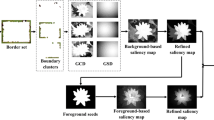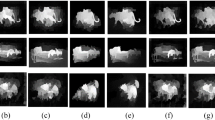Abstract
The majority of existing methods for saliency detection based on low-level features failed to uniformly highlight the salient-object regions. In order to improve the accuracy and consistency of generated saliency maps, we propose a novel and efficient framework by combining low-level saliency priors and local similarity cues for image saliency detection. Firstly, we construct a multiple low-level prior map using location prior, color prior and background prior. Then, the prior maps employ a propagation mechanism based on Cellular Automata to enforce relevance of similar regions as a local similarity cue. Finally, a principle refinement framework by integrating multi-level prior maps and local similarity cue map are used to obtain an ultimate high-quality saliency map. Extensive experiments on publicly available datasets show that our designed approach is capable of producing accurate saliency maps compared with those generated results by the state-of-the-art saliency-detection methods.







Similar content being viewed by others
References
Achanta R, Hemami S, Estrada F et al (2009) Frequency-tuned salient region detection. IEEE Computer Vision and Pattern Recognition:1597–1604
Achanta R, Shaji A, Smith K, Lucchi A, Fua P, Süsstrunk S (2012) SLIC superpixels compared to state-of-the-art superpixel methods. IEEE Trans Pattern Anal Mach Intell 34(11):2274–2282
Chang K-Y, Liu T-L, Chen H-T, Lai S-H (2011) Fusing generic objectness and visual saliency for salient object detection. Proc IEEE Int Conf Comput Vis:914–921
Cheng MM, Mitra NJ, Huang X et al (2015) Global contrast based salient region detection. IEEE Trans Pattern Anal Mach Intell 37(3):569–582
Cheng M, Warrell J, Lin W, Zheng S, Vineet V, Crook N (2013) Efficient salient region detection with soft image abstraction. Proc IEEE Int Conf Comput Vis:1529–1536
Cholakkal H, Rajan D, Johnson J (2015) Top-down saliency with locality-constrained contextual sparse coding. BMVC
Goferman S, Zelnik-Manor L, Tal A (2012) Context-aware saliency detection. IEEE Trans Pattern Anal Mach Intell 34(10):1915–1926
Harel J, Koch C, Perona P (2006) 'Graph-based visual Saliency', Advances in Neural Information Processing Systems, pp. 545–552
He S, Lau RWH, Yang Q (2015) Exemplar-Driven Top-Down Saliency Detection via Deep Association. IJCV 115(3):330–344
Hou X, Harel J, Koch C (2012) Image signature: Highlighting sparse salient regions. IEEE Trans Pattern Anal Mach Intell 34(1):194–201
Hou X, Zhang L (2007) Saliency Detection: A spectral residual approach. IEEE Conference on Computer Vision and Pattern Recognition:1–8
Huang F et al (2017) Salient object detection via multiple instance learning. IEEE Trans Image Process 26(4):1911–1922
Itti L, Koch C, Niebur E (1998) A model of saliency based visual attention for rapid scene analysis. IEEE Trans Pattern Anal Mach Intell 20(11):1254–1259
Jian M, Lam K-M, Dong J, Shen L (2015) Visual-patch-attention-aware Saliency Detection. IEEE Transactions on Cybernetics 45(8):1575–1586
Jian M, Qi Q, Dong J, Yin Y, Lam K-M (2018) Integrating QDWD with Pattern Distinctness and Local Contrast for Underwater Saliency Detection. J Vis Commun Image Represent 53:31–41
Jian M et al (2018) Saliency Detection Using Quaternionic Distance Based Weber Local Descriptor and Level Priors. Multimed Tools Appl 77(11):14343–14360
Jiang H, Wang J, Yuan Z, Liu T, Zheng N, Li S (2011) Automatic salient object segmentation based on context and shape prior. Proc Brit Mach Vis Conf:1–12
Jing H, He X, Han Q, El-Latif AAA, Niu X (2014) Saliency detection based on integrated features. Neurocomputing 129(10):114–121
Jung C, Kim C (2012) A unified spectral – domain approach for saliency detection and its application to automatic object segmentation. TIP 21(3):1272–1283
Kim J, Han D, Tai Y, Kim J (2014) Salient region detection via high-dimensional color transform. IEEE Conference on Computer Vision and Pattern Recognition:883–890
Li J, Chen H, Li G et al (2015) Salient object detection based on meanshift filtering and fusion of colour information. IET Image Process 9(11):977–985
Li J et al (2010) Probabilistic multi-task learning for visual saliency estimation in video. Int J Comput Vis 90(2):150–165
Liu X, Huet B (2016) Event-based cross media question answering. Multimed Tools Appl 75(3):1495–1508
Liu T, Sun J, Zheng N et al (2011) Learning to detect a salient object. IEEE Trans Pattern Anal Mach Intell 33(2):353–367
Liu X, Wang M, Yin B, Huet B, Li X (2015) Event-Based Media Enrichment Using an Adaptive Probabilistic Hypergraph Model. IEEE T Cybernetics 45(11):2461–2471
Ma YF, Zhang HJ (2003) Contrast-based image attention analysis by using fuzzy growing', Proceedings of the Eleventh ACM International Conference on Multimedia, pp. 374–381
Mahadevan V, Vasconcelos N (2009) Saliency-based discriminant tracking. Computer Vision and Pattern Recognition, 2009. CVPR 2009. IEEE Conference on, IEEE
Mahadevan V, Vasconcelos N (2010) Spatiotemporal saliency in dynamic scenes. IEEE Trans Pattern Anal Mach Intell 32(1):171–177
Movahedi V, Elder JH (2010) Design and perceptual validation of performance measures for salient object segmentation. IEEE Conference on Computer Vision and Pattern Recognition Workshops:49–56
MSRA (2019). http://research.microsoft.com/en-us/um/people/jiansun/SalientObject/salient_object.htm
Peng H et al (2017) Salient object detection via structured matrix decomposition. IEEE Trans Pattern Anal Mach Intell 39(4):818–832
Qin Y et al (2015) Saliency detection via cellular automata. Computer Vision and Pattern Recognition (CVPR), 2015 IEEE Conference on, IEEE
Scharfenberger C, Wong A, Fergani K, Zelek JS, Clausi DA (2013) Statistical textural distinctiveness for salient region detection in natural images. Proc IEEE Conf Comput Vis Pattern Recog:979–986
Shen X, Wu Y (2012) A unified approach to salient object detection via low rank matrix recovery. Proc IEEE Conf Comput Vis Pattern Recog:2296–2303
Shi J et al (2016) Hierarchical image saliency detection on extended CSSD. IEEE Trans Pattern Anal Mach Intell 38(4):717–729
Song H, Liu Z, Xie Y et al (2016) RGBD Co-saliency Detection via Bagging-Based Clustering. IEEE Signal Processing Letters 23(12):1707–1711
Song J, Zhang H, Li X, Gao L, Wang M, Hong R (2018) Self-Supervised Video Hashing With Hierarchical Binary Auto-Encoder. IEEE Trans Image Processing 27(7):3210–3221
Toshev A, Shi J, Daniilidis K (2007) Image matching via saliency region correspondences. Computer Vision and Pattern Recognition, 2007. CVPR'07. IEEE Conference on, IEEE
Wei Y, Wen F, Zhu W, Sun J (2012) Geodesic saliency using background priors. Proc Eur Conf Comput Vis:29–42
Wolfram S (1983) Statistical mechanics of cellular automata. Rev Mod Phys 55(3):601
Yan Q, Xu L, Shi J, Jia J (2013) Hierarchical saliency detection. Proc IEEE Conf Comput Vis Pattern Recog:1155–1162
Yang J, Yang MH (2017) Top-down visual saliency via joint CRF and dictionary learning. IEEE Transactions on PAMI 39(3):576–588
Yang C, Zhang L, Lu H (2013) Graph-regularized saliency detection with convex-hull-based center prior. IEEE Signal Processing Letters 20(7):637–640
Yang C et al (2013) Saliency detection via graph-based manifold ranking. Computer Vision and Pattern Recognition (CVPR), 2013 IEEE Conference on, IEEE
Zhai Y, Shah M (2006) Visual attention detection in video sequences using spatiotemporal cues. In: Proc. 14th ACM Int. Conf. Multimedia, pp 815–824
Zhang H, Kyaw Z, Chang SF, Chua TS (2017) Visual Translation Embedding Network for Visual Relation Detection. CVPR:3107–3115
Zhang J, Sclaroff S (2016) Exploiting Surroundedness for Saliency Detection: A Boolean Map Approach. IEEE Trans Pattern Anal Mach Intell 38(5):889–902
Zhu W, Liang S, Wei Y, Sun J (2014) Saliency optimization from robust background detection. Proc IEEE Conf Comput Vis Pattern Recognit:2814–2821
Acknowledgements
We would like to thank Prof. Hui Yu in the School of Creative Technologies, University of Portsmouth, for providing technical editing and proofreading of the manuscript.
This work was supported by National Natural Science Foundation of China (NSFC) (61601427, 61602229, 61771230); Royal Society – K. C. Wong International Fellow; Natural Science Foundation of Shandong Province (ZR2016FM40); Shandong Provincial Key Research and Development Program of China (NO. 2017CXGC0701); Fostering Project of Dominant Discipline and Talent Team of Shandong Province Higher Education Institutions.
Author information
Authors and Affiliations
Corresponding author
Additional information
Publisher’s note
Springer Nature remains neutral with regard to jurisdictional claims in published maps and institutional affiliations.
Rights and permissions
About this article
Cite this article
Jian, M., Wang, J., Dong, J. et al. Saliency detection using multiple low-level priors and a propagation mechanism. Multimed Tools Appl 79, 33467–33482 (2020). https://doi.org/10.1007/s11042-019-07842-4
Received:
Revised:
Accepted:
Published:
Issue Date:
DOI: https://doi.org/10.1007/s11042-019-07842-4




